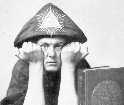

|
Introduction to Crowley |
| web collection · essays · journal · about the author · send me e-mail |

In Fall 1997 this 10,000 word piece came forth over the period of a few hours, preceding the end of my four-year relationship and my then-longest job. I was concerned that no living writer was looking at Aleister Crowley from a critical perspective, as opposed to muckraking or defensive advocacy writing. The literary conceit of the five voices was intended to broaden the scope of public opinion. It will be published in an improved and expanded form, with two new chapters and an additional voice, in the upcoming disinformation anthology in 2003.
Aleister Crowley (1875-1947) created a tradition known as Thelema, which is a spiritual or religious system centered around ideas of freedom and personal growth. If you study Crowley or Thelema you will encounter some common themes. This introduction deals with some of the major themes, but only in summary form. Real study requires independent work with the primary sources.
A traditional introduction to a religious system would set forth specific teachings and practices that its members would be expected to echo with one voice, but Thelema recognizes the validity and holiness of many different voices. This introduction takes the form of five different voices with five different agendas. Your voice is your own to evolve. Your views may or may not resemble any of the views of this introduction. Even if some thought you hold seems almost identical with one of the ideas in this introduction -- or utterly incompatible with all of them! -- it will still be uniquely yours, embedded firmly in your own personal matrix of thought and life in an individual, unique, irreplaceable and sacred way.
The five characters are myself, the Unreliable Narrator, on the main text, and four fictional characters in the voices: the Literalist, the Chaotic, the Skeptic and the Mystic. They are composite voices drawn loosely from the real world. I do not always agree with them, and they do not always agree with each other. I have attempted to show both their strong points and their weak points. No doubt I have also revealed some of my own in the process.
Many thanks to reviewers: Lilinah Biti-Anat, Leigh Ann Hussey, Ramona Ruiz, Jeffrey Smith. All errors are the fault of the author.
